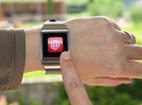According to three recent studies, enterprise wearables are set for heavy growth within the next few years. The drivers for the growth include health care, government, energy, industrial and field-service heavy sectors such as oil and gas companies. Data from these research projects show that the market will expand through 2020, with many enterprises deploying devices in the next year:
- According to Compass Intelligence research available through Research and Markets, the wearables category will reach $8.5 billion by 2020. The compound annual growth rate (CAGR) between this year and 2019 will be 139 percent. This dwarfs the CAGR of the consumer sector, which will be 38 percent, the company said.
- The VAR Guy reports that 39 percent of U.S. IT decision makers surveyed by 451 Research who are interested in wearables have deployed them or will do so within the next six months. Twenty-four percent more will do so within the next year. The study also found that 81 percent of those who plan to deploy within six months will deploy wearable watches.
- A pair of surveys from Compass Intelligence – one over five years and one for the second quarter of this year — point to growth in wearables as well. It also identifies growth coming from efforts to promote employee health and wellness.
Enterprise wearables often are assumed to take a similar development path as BYOD work structures; however, there are significant differences. The differences center on the arc of introduction: The initial BYOD trend occurred after smartphones and tablets were already well-established consumer devices. To date, wearables are still a niche. Indeed, it is just as likely that specific enterprise applications will continue to drive acceptance of the devices by consumers and the enterprise.
One of the key similarities between BYOD devices and wearables, not surprisingly, is the need for security. Vendors are responding. Computerworld’s Jonny Evans reported in late June that Good Technology has expanded its Good Work product to include Apple Watch. The product will enable control over Apple Watch via a Web-based console. The need, Evans writes, is clear:
It is inevitable these things will be used for all kinds of collaboration in unified communications or SaaS deployments. However, to support such use IT pros will want to implement complete policy control over the device – they have to, if only to satisfy data protection law.
That commentary is aimed at the Apple product, but clearly can be extended over all wearable technology. An illustration of the growing attention being paid to wearables by enterprise organizations is the investment by SalesForce Ventures – the investment arm of Salesforce.com – in APX Labs, a company whose technology is focused on heavy industry, according to NASDAQ:
APX Labs’ wearable tech software is mostly used in heavy industries like energy, telecommunications, automotive and aerospace. The app is believed to improve the entire workflow of the companies with its various features like, contract approval and sending email with just a tap.
The article details other ways that Salesforce is establishing itself as a leader in wearable tech software:
Salesforce has always encouraged wearable devices. So by investing in APX Labs, the company is trying to strengthen its position in the wearable tech software space. Some of its other investments in wearable startups include Speakeasy – a conference calling software, and PULS – Will.i.am’s smartwatch company.
Carl Weinschenk covers telecom for IT Business Edge. He writes about wireless technology, disaster recovery/business continuity, cellular services, the Internet of Things, machine-to-machine communications and other emerging technologies and platforms. He also covers net neutrality and related regulatory issues. Weinschenk has written about the phone companies, cable operators and related companies for decades and is senior editor of Broadband Technology Report. He can be reached at [email protected] and via twitter at @DailyMusicBrk.



